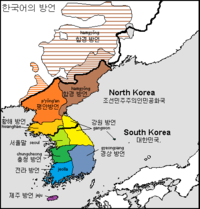The geographically proximate languages of Japanese (part of the Japonic languages) and Korean (part of the Koreanic languages) share considerable similarity in syntactic and morphological typology while having a small number of lexical resemblances. Observing the said similarities and probable history of Korean influence on Japanese culture, linguists have formulated different theories proposing a genetic relationship between them, [1] [2] [3] [4] [5] [6] [7] [8] though these studies either lack conclusive evidence or were subsets of theories that have largely been discredited (like versions of the well-known Altaic hypothesis that mainly attempted to group the Turkic, Mongolian and Tungusic languages together). [9] [10] [11] [12] There has been new research which has revived the possibility of a genealogical link, such as the Transeurasian hypothesis (a neo-Altaic proposal) by Robbeets et al., supported by computational linguistics and archaeological evidence, but this view has received significant criticism as well. [13] [14]
Korean and Japanese have very different native scripts ( Hangul and kana, respectively), although they both make use of Chinese characters to some extent; Kanji still are a core part of modern Japanese orthography, while Hanja were historically used to write Korean. Today, Hanja are only used in South Korea for limited academic, legal, media, stylistic and disambiguation purposes and are not used at all in North Korea. Although both Hangul and the two modern kana systems ( katakana and hiragana) show syllable/ mora boundaries, Hangul syllable blocks break down into a featural alphabet, while the kana are essentially pure syllabaries.
Overview
| Korean | Japanese | |
|---|---|---|
| Speakers | 83 million | 126.4 million |
| Countries | ||
| Family | Koreanic | Japonic |
| Writing |
Hangul, Hanja (South Korea), Idu, Gugyeol, Hyangchal (formerly) |
Kana, Kanji, Man'yōgana (formerly) |
Grammar
Korean and Japanese both have an agglutinative morphology in which verbs may function as prefixes [15] and a subject–object–verb (SOV) typology. [16] [17] [18] They are both topic-prominent, null-subject languages. Both languages extensively utilize turning nouns into verbs via the "to do" helper verbs (Japanese suru する; Korean hada 하다).
Vocabulary
The two languages have been thought to not share any cognates (other than loanwords), [4] for their vocabularies do not phonetically resemble each other. There is a minority theory attributing the name of the city Nara to a loanword from Korean (see: Nara, Nara#Etymology).
Numerals
Similarities have been drawn between the four attested numerals of Goguryeo, an ancient Korean relative, and its equivalents in Old Japanese. [19] [20]
| Numeral | Goguryeo | Old Japanese |
|---|---|---|
| 3 | mil | mi1 |
| 5 | uc | itu |
| 7 | na-nin | nana |
| 10 | dok | to2 / to2wo |
Note: See Jōdai Tokushu Kanazukai for information on Old Japanese subscript notation.
Writing
Both languages use, to some extent, a combination of native scripts and Chinese characters.
Korean is mostly written in the Korean featural alphabet (known as Hangul in South Korea and Chosŏn'gŭl in North Korea). The traditional hanja (Chinese characters adapted for Korean) are sometimes used in South Korea, but only for specific purposes such as to clarify homophones (especially in TV show subtitles), linguistic or historic study, artistic expression, legal documents, and newspapers. Native Korean words do not use hanja anymore. In North Korea, the hanja have been largely suppressed in an attempt to remove Chinese influence, although they are still used in some cases and the number of hanja taught in North Korean schools is greater than that of South Korean schools. [21]
Japanese is written with a combination of kanji (Chinese characters adapted for Japanese) and kana (two writing systems representing the same sounds, composed primarily of syllables, each used for different purposes). [22] [23] Unlike Korean hanja, however, kanji can be used to write both Sino-Japanese words and native Japanese words.
Historically, both Korean and Japanese were written solely with Chinese characters, with the writing experiencing a gradual mutation through centuries into its modern form. [24]
Honorifics
Both languages have similar elaborate, multilevel systems of honorifics, and furthermore both Korean and Japanese also separate the concept of honorifics from formality in speech and writing in their own ways (See Korean speech levels and Honorific speech in Japanese § Grammatical overview). They are cited as the two most elaborate honorific systems, perhaps unrivaled by any other languages. [25] It has been argued that certain honorific words may share a common origin. [26] Uniquely, the honorifics rely heavily on changing verb conjugations rather than only using t-v distinction or other common methods of signifying honorifics. See Korean honorifics and Japanese honorifics.
See also
- Baekje language
- Classification of the Japonic languages
- Japonic languages
- Koreanic languages
- Peninsular Japonic
References
- ^ Andrew Logie (November 22, 2013). "Are Korean and Japanese related? The Altaic hypothesis continued". Koreanology. Retrieved February 17, 2016.
- ^ Kornicki, Peter. Aston, Cambridge and Korea Archived May 29, 2008, at the Wayback Machine
- ^ Poppe 1965:137
- ^ a b Martin, Samuel (1990).
- ^ Whitman, John (1985).
- ^ E. Riley, Barbara (2004).
- ^ Starostin, Sergei (Moscow, 1991). The Altaic Problem and the Origins of the Japanese Language.
- ^ Georg et al. 1999:72, 74
- ^ "While 'Altaic' is repeated in encyclopedias and handbooks most specialists in these languages no longer believe that the three traditional supposed Altaic groups, Turkic, Mongolian and Tungusic, are related." Lyle Campbell & Mauricio J. Mixco, A Glossary of Historical Linguistics (2007, University of Utah Press), pg. 7.
- ^ "When cognates proved not to be valid, Altaic was abandoned, and the received view now is that Turkic, Mongolian, and Tungusic are unrelated." Johanna Nichols, Linguistic Diversity in Space and Time (1992, Chicago), pg. 4.
- ^ "Careful examination indicates that the established families, Turkic, Mongolian, and Tungusic, form a linguistic area (called Altaic)...Sufficient criteria have not been given that would justify talking of a genetic relationship here." R.M.W. Dixon, The Rise and Fall of Languages (1997, Cambridge), pg. 32.
- ^ "...[T]his selection of features does not provide good evidence for common descent" and "we can observe convergence rather than divergence between Turkic and Mongolic languages--a pattern than is easily explainable by borrowing and diffusion rather than common descent", Asya Pereltsvaig, Languages of the World, An Introduction (2012, Cambridge) has a good discussion of the Altaic hypothesis (pp. 211-216).
- ^ Robbeets, Martine and Bouckaert, Remco. Bayesian phylolinguistics reveals the internal structure of the Transeurasian family Archived July 27, 2020, at the Wayback Machine, Robbeets, Martine et al. 2021 Triangulation supports agricultural spread of the Transeurasian languages, Nature 599, 616–621
- ^ Tian, Zheng; Tao, Yuxin; Zhu, Kongyang; Jacques, Guillaume; Ryder, Robin J.; de la Fuente, José Andrés Alonso; Antonov, Anton; Xia, Ziyang; Zhang, Yuxuan; Ji, Xiaoyan; Ren, Xiaoying; He, Guanglin; Guo, Jianxin; Wang, Rui; Yang, Xiaomin; Zhao, Jing; Xu, Dan; Gray, Russell D.; Zhang, Menghan; Wen, Shaoqing; Wang, Chuan-Chao; Pellard, Thomas (June 12, 2022), Triangulation fails when neither linguistic, genetic, nor archaeological data support the Transeurasian narrative, Cold Spring Harbor Laboratory, doi: 10.1101/2022.06.09.495471, S2CID 249649524
- ^ Bernard Comrie: "Introduction", p. 7 and 9 in Comrie (1990).
- ^ S. Tomlin, Russell. Surveyed in the 1980s.
- ^ Introducing English Linguistics International Student Edition by Charles F. Meyer
- ^ Russell Tomlin, "Basic Word Order: Functional Principles", Croom Helm, London, 1986, page 22
- ^ Shinmura, Izuru (1916). "國語及び朝 鮮語の數詞について [Regarding numerals in Japanese and Korean]". Geibun. 7.2–7.4.
-
^ Yi, Ki-Mun (1972). "Kugosa Kaesol [Introduction to the history of Korean]". Seoul: Minjung Sogwan.
{{ cite journal}}: Cite journal requires|journal=( help) - ^ Hannas 1997: 68. "Although North Korea has removed Chinese characters from its written materials, it has, paradoxically, ended up with an educational program that teaches more characters than either South Korea or Japan, as Table 2 shows."
- ^ Advances in Psychology Research. Google Books. Books.google.co.uk. Retrieved on 2013-08-24.
- ^ Learning Japanese in the Network Society. Google Books. Books.google.co.uk. Retrieved on 2013-08-24.
- ^ The Handbook of Korean Linguistics By Jaehoon Yeon
- ^ Brown, Lucien (2008). "Contrasts Between Korean and Japanese Honorifics". Rivista Degli Studi Orientali. 81 (1/4): 369–385. JSTOR 41913346.
- ^ "Grammaticalization in Sentence-Final Politeness Marking in Korean and Japanese".


